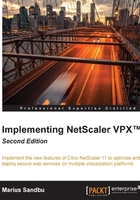
上QQ阅读APP看书,第一时间看更新
Summary
We have now gone through the basics of NetScaler, covering the basics and the definition of an ADC, how it works, and also a bit on the different models and editions we can choose from. We also went through some advanced feature modes, and how NetScaler processes traffic for a sample web service. Lastly, we looked at how NetScaler handles traffic for a load-balanced service, and how we can add VLANs.
So, to sum it up, this is what we did to get NetScaler up and running:
- Imported the virtual machine in a virtual environment or in a public cloud
- Performed the initial setup of NetScaler using CLI by setting the NSIP
- Changed the default password from
nsroot - Added a platform license to enable more features
- Added additional IP addresses, such as SNIP, to enable backend communications
- Added a DNS server for name lookup and an NTP server for time synchronization
- Configured modes depending on the network topology
- Saved the configuration
In the next chapter, we will look more closely at the NetScaler Gateway and Unified Gateway feature, which is commonly used for XenApp/XenDesktop environments, and we will also have a look at the different modes it can operate in.